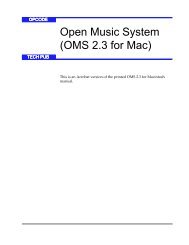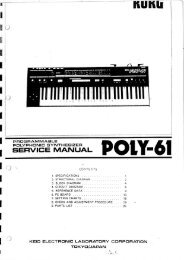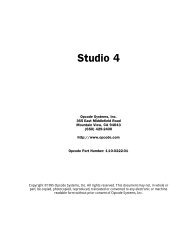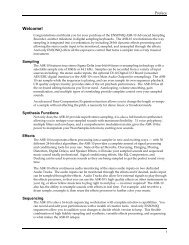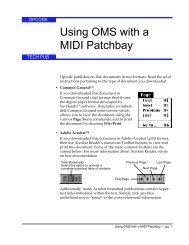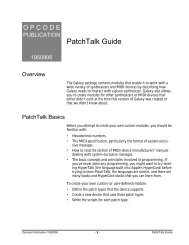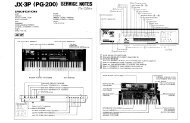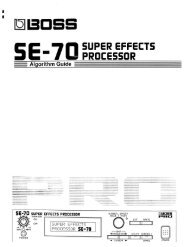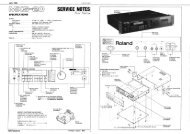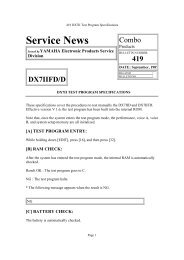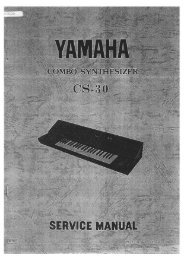Vision and Studio Vision Pro Version 4.1 Manual ... - House of Synth
Vision and Studio Vision Pro Version 4.1 Manual ... - House of Synth
Vision and Studio Vision Pro Version 4.1 Manual ... - House of Synth
Create successful ePaper yourself
Turn your PDF publications into a flip-book with our unique Google optimized e-Paper software.
PART 3: The Acadia Audio System<br />
Mono <strong>and</strong> Stereo Plug-Ins<br />
There are basically three types <strong>of</strong><br />
plug-ins:<br />
• mono in/mono out<br />
These plug-ins can only be assigned<br />
to a mono Audio Instrument (or<br />
mono input, output, or bus), <strong>and</strong> their<br />
output can only be connected to<br />
another “mono in” plug-in.<br />
• mono in/stereo out<br />
These plug-ins can only be assigned<br />
to a mono Audio Instrument (or<br />
mono input, output, or bus), <strong>and</strong> their<br />
output is generally connected to a<br />
“stereo in” plug-in.<br />
<strong>Vision</strong> can, however, use this plug-in<br />
type as a mono in/mono out plug-in<br />
by only outputting its left channel.<br />
When viewing mono in/stereo out<br />
plug-ins in the Plug-In Selector popup,<br />
a duplicate <strong>of</strong> each plug-in<br />
(labeled as “mono”) is displayed in<br />
the left column <strong>of</strong> the menu.<br />
• stereo in/stereo out<br />
These plug-ins can only be assigned<br />
to a stereo Audio Instrument (or<br />
stereo input, output, or bus), <strong>and</strong><br />
their output can only be connected to<br />
another “stereo in” plug-in.<br />
Some VST plug-ins can be used in just one<br />
mode. Still others can be used in two<br />
modes—mono in/stereo out or stereo in/<br />
stereo out.<br />
Some manufactures, on the other h<strong>and</strong>,<br />
provide two different versions <strong>of</strong> their<br />
plug-ins for connecting to either mono or<br />
stereo. Usually, these plug-ins are named<br />
accordingly (for instance, “DeNoiserM”<br />
<strong>and</strong> “DeNoiserS”).<br />
<strong>Vision</strong> represents plug-in routings graphically<br />
in the Console Window, as shown in<br />
Figure 7.6.<br />
Audio Instr: MONO<br />
Plug-In: NONE<br />
Audio Instr: MONO<br />
Plug-In: MONO<br />
Audio Instr: MONO<br />
Plug-In: MONO IN/STEREO OUT<br />
Audio Instr: STEREO or<br />
MONO (See NOTE 1)<br />
Plug-In: STEREO<br />
Audio Instr: STEREO or<br />
MONO (See NOTE 1)<br />
Plug-In: NONE<br />
Figure 7.6: Graphic indication <strong>of</strong> stereo status<br />
NOTE: A mono Audio Instrument can<br />
have stereo plug-in inputs if the plug-in<br />
above it contains a mono in/stereo out<br />
plug-in. For more information, see “Using<br />
Mono Plug-Ins (pg. 51).”<br />
50 Opcode Systems, Inc.



